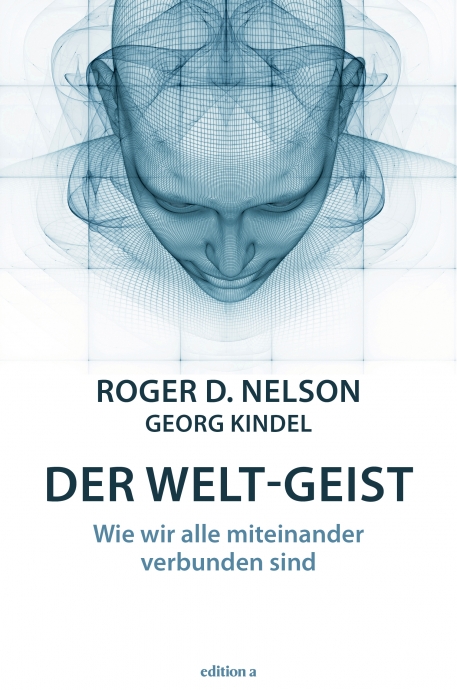
Reviewed by Gerhard Mayer
Psychologist Roger Nelson was the scientific coordinator of the Princeton Engineering Anomalies Research (PEAR) lab, directed by Robert Jahn (1930–2017). Anyone who has had the chance to meet Nelson knows about his human qualities, his warm-heartedness, kindness, and humour, to mention only a few. He was involved in cutting-edge research in the field of experimental parapsychology and is well informed about the methodological debates regarding study design and evaluation as well as the pitfalls of interpretation of results. Nelson is also well aware of all kind of critiques coming from colleagues and sceptics alike. Now he has co-authored a new book, together with Georg Kindel, published in German. The precise function of his co-author remains unclear because almost the entire book is written from a first-person perspective. Provocatively, the book is entitled Der Welt-Geist. Wie wir alle miteinander verbunden sind [The world spirit. How we all are connected].
When I started to read the book, I expected to read a popular scientific account about the so-called Global Consciousness Project (GCP) that Nelson and others initiated in 1997, it is now running under his leadership (Nelson, 2015). This project consists of a worldwide network of random number generators whose output of random sequences are permanently recorded. Sometimes significant deviations occur which appear to be correlated with events or occurrences that seem of “global importance”. This was the case after the 9/11 terror attacks in New York. The basic idea is that something like a “field of consciousness” is formed when many people direct their thoughts toward the same event. With this in mind, the choice of the ambitiously sounding book title becomes more comprehensible: it should describe the idea of a global consciousness which combines together the conscious mental activities of many single persons.
“Globales Bewusstsein” would be a more suitable book title rather than “Welt-Geist” with its reference to German philosophy of idealism. Exactly this choice of the title, this ‘loose translation’, as well as the series title “Wahres Leben” [true life] reveals what kind of book this really is. It is a work deeply shaped by Nelson’s own personal philosophy of life, which is also more or less explicitly described. His experiential spectrum as a cognitive psychologist, scientist, and also as a regularly meditating person is obviously reflected in the text. Thus, the reader is being informed about Nelson’s research into the field of parapsychology, and all the implications resulting from it, especially for our understanding of consciousness.
Although the reader learns a great deal about exciting experimental results, be it of PK experiments, the GCP, out-of-body experiences, spiritual healing and meditation research, to mention only a few topics, the book is not, strictly speaking, a “popular” scientific presentation of research because the results Nelson presents are used to support a specific worldview. The many controversies that still, and in many regards quite justified, are accompanying the research findings are not mentioned. For example, the GCP has been subject to much discussion (last year in Explore and in the Journal of Nonlocality).
No alternative explanations of the sometimes very intriguing results are discussed or mentioned. Results are interpreted and presented as “evidence of a global consciousness” (translation by G.M.), largely based on a model of (classical) causal connections. The possibility of acausal connections according to Jung’s concept of synchronicity (unus mundus) or Taoist ideas are not considered (see e.g. Browne, 2017) except when Nelson takes a quick glance at the possible role of coincidence in his journey of life (pp. 214-215). Ultimately, clear definitions of “global consciousness”, “group consciousness”, or “world spirit” are not provided. Therefore, it is not possible to come to an appropriate assessment, from a philosophical point of view, of the conclusions the author draws. However, despite this critique from a scientific and philosophical perspective, many will read the book with benefit. It is a likeable book.
The book was apparently finished somewhat hastily. I received the book early in May 2018. On pages 74 to 80 a (dramatic!) event of 13 January 2018 is discussed – an alleged rocket attack aimed at Hawaii which fortunately turned out to be a false alarm: a highly interesting event from the viewpoint of GCP, which is quite rightly taken into account. On page 190 another event is mentioned that took place on 13 February 2018 (the start of the research project ICARUS). This short period between finishing the manuscript and publication is unfortunately reflected in several failures of hyphenation and comma placement as well as clumsy translations. With regard to technical descriptions at the beginning of the book the author responsible for the translation apparently did not fully understand everything which resulted in somewhat senseless technical gibberish (pp. 21-22). No doubt, the German translation would have profited enormously from more editorial work.
PS
Georg Kindel is a former journalist with a lot of contacts to prominent people. He founded several “World Awards” and is also founder and chief operating officer of OOOM, a media and communication company, which also publishes a sort of a lifestyle magazine (OOOM magazine).
References
Browne, L. (2017). The many faces of coincidence. Exeter: Imprint Academic.
Nelson, R. D. (2015): Implicit physical psi: The Global Consciousness Project. In E. Cardeña, J. Palmer, & D. Marcusson-Clavertz (Eds.). Parapsychology: A Handbook for the 21st century (pp. 282–292). Jefferson, NC: McFarland.

